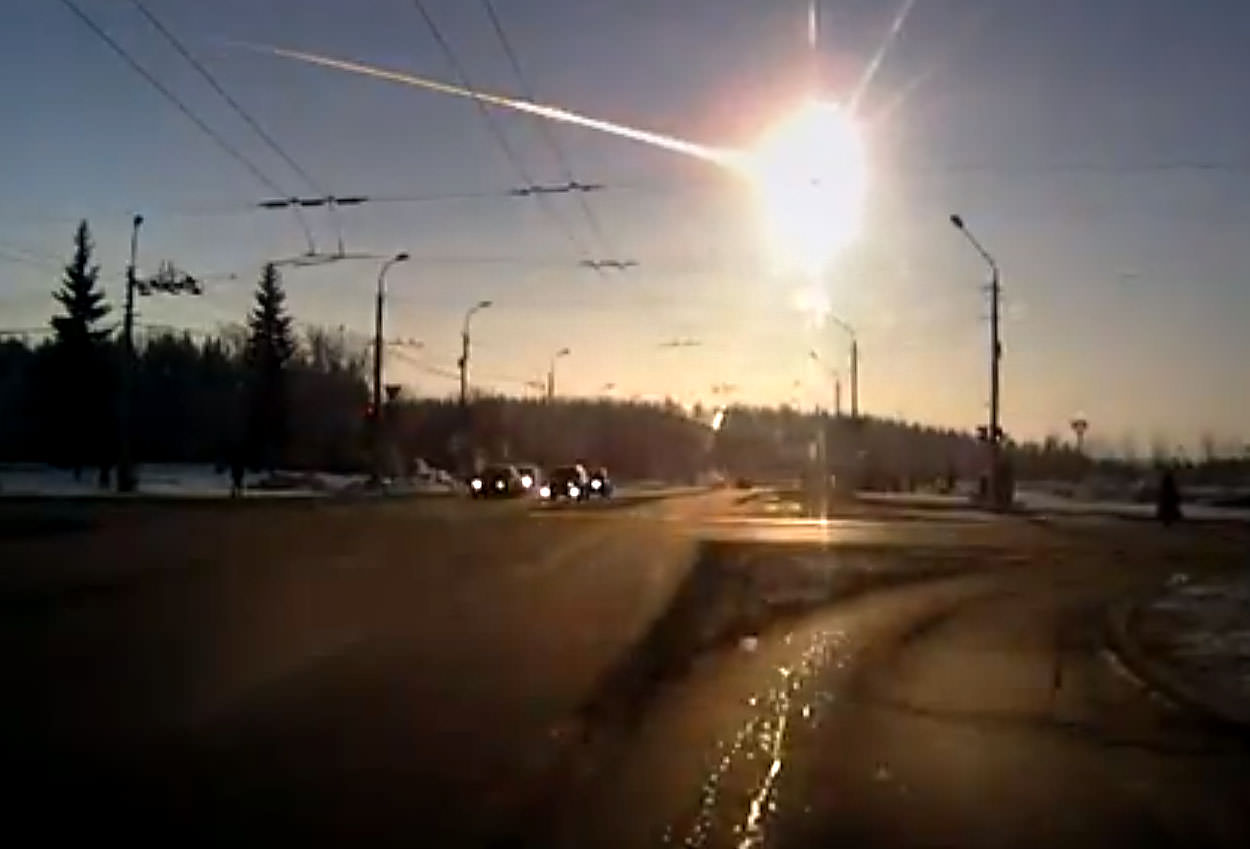Watch Meteor Strike on PBS. See more from NOVA.
It was an event that took the world by surprise: On the morning of February 15, 2013 a 7,000-ton asteroid crashed into the Earth’s atmosphere. According to NASA, the Siberian meteor exploded with the power of 30 Hiroshima bombs and was the largest object to burst in the atmosphere since the Tunguska event of 1908. This video from PBS’s science show NOVA aired last night on television and is now available to watch online. (Note: the video may not yet be available to watch in all areas of the world.)
The show reveals what scientists have gleaned so far about this object from the numerous dashcam videos in Russia and other data, and how this event could have been much worse.
It features interviews with several scientists, including Peter Brown and Margaret Campbell-Brown from the University of Western Ontario, Mark Boslough from the University of New Mexico, Dan Durda from the Southwest Research Institute and Apollo 9 astronaut Rusty Schweickart, who is now Chair Emeritus of the B612 Foundation, the organization that is building the “Sentinel” telescope to search for asteroids heading for Earth.


Funny how some educated scientists in here say they are not concerned. Well, I am. As I stated before. The odds are there. We have been having more events. I work w/a Russian scientist who as a child w/his siblings, lived 40 miles from G-Zero.
His brother now occupies their old homestead. That air-blast broke ‘most’ windows in their house & leveled a 20’X12’X10′ older oak shed. Leveled it! That’s 40 miles away! Although it was not a Tunguska like rock. Never the less, it was devastating to many Russian people who went through it.
If memory serves me, this rock was NOT tracked. Imagine a rock the size of Tunguska over a heavily populated area? KABOOM! Death & destruction galore. We need “ALL” Gov’s to ramp up R&D to track & come up w/a method to deflect or annihilate the rock w/out causing the fragments to affect us below. It can be done! The whole key is===>R&D!
Take care all.
“Imagine a rock the size of Tunguska over a heavily populated area?”
Care to run a quick calculation of the odds of that, even given a strike? IF you do that, then we can talk about how much in resources we should devote to such endeavors.
How’s it go? Better safe than sorry?… or… An ounce of prevention is worth a pound of cure?
Proactive: /pr??aktiv/ Adjective(of a person, policy, or action) Creating or controlling a situation by causing something to happen rather than responding to it after…
Well said qua4U….damn well said. I will repeat it, ….damn well said ;-)… My whole point.
Obviously none of you are insurance actuaries (but you are insurance salesmen’s dream clients!). You all act like we have unlimited resources and can address EVERY POSSIBLE hazard out there. I don’t think so. Resources used for something like this have to come from somewhere- and have effects because of that. What would you like to not spend money on to fund this extreme long shot? Are you insured against lightning strike? Much higher odds of that happening.
I get your point. Its “$”, and so duly noted. Good point ;-). i have no clue what coverage they would come up with or the amount.
Insurance is not the point or fact.Tell those Russians the odds! Those odds ‘hit’. A lot were hurt, …& damage galore, …but thank the Lord no one died. If it were a Tunguska type blast?.Bye bye Russian city & most of the human inhabitants as well. I do NOT go by odds. I go by===>”It is not a question of “if odds”, but “WHEN odds”. And no, ‘we’ here & ‘me’ are not ins.-actuaries Most are space type scientists, …some are here just to learn. More the merrier. Take care.
Uummm, what difference does odds make? 1 is tooooooooooooooooo many! Re-read what Aqua4U said so very well to you. ..
Low probability, but HIGH consequence, means it is a possibility that needs to be addressed.
Exactly.
A great show.. saw it last night 03.27.13. Well worth watching again!
Have I missed something? Are the Urals in Siberia or many miles furthe south and west?
No your right on. Considering Siberia is huge. The Urals are in Siberia. I believe it is in the western Russian Federation/old Soviet Union. They extend from N & S from the Arctic ocean to very near the Caspian sea forming a excellent natural boundary between Asia & Europe. Ok, this Geo lesson is done for the day ;-)… Take care
As a side note: If anyone has wondered why so many Russian drivers have installed dashcams in their vehicles, strap-on your seatbelt, and watch Deutsche Welle’s “European Journal” video report for the shocking answer (first segment of that week’s half-hour program).
http://www.dw.de/european-journal-the-magazine-from-brussels-2013-03-20/e-16634134-9798